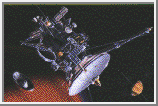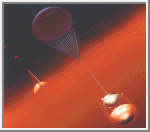















|
Courtesy of the Jet Propulsion Laboratory
Circled by distinctive rings and attended by a group of at least 18 moons, Saturn has been called one of the most intriguing planetary realms in the solar system. Its largest moon, Titan, boasts organic chemistry that may hold clues to how life formed on the primitive Earth. So it is that Saturn and Titan will be the destination of the Cassini mission, a project under joint development by NASA, the European Space Agency and the Italian Space Agency. The U.S. portion of the mission is managed for NASA by the Jet Propulsion Laboratory. Cassini's principal objectives are:
Cassini will be launched in October 1997 atop a Titan IV-Centaur rocket from Cape Canaveral, Florida. Cassini will first execute two gravity-assist flybys of Venus, then one each of the Earth and Jupiter to send it on to arrive at Saturn in July 2004. Upon reaching Saturn, Cassini will swing close to the planet -- to an altitude only one-sixth the diameter of Saturn itself -- to begin the first of some five dozen orbits during the rest of its four-year mission. In late 2004, the spacecraft will release the European-built Huygens probe for its descent of up to two-and-a-half hours through the dense atmosphere of Saturn's moon Titan. The instrument-laden probe will beam its findings to the Cassini orbiter to be stored and finally relayed back to Earth. During the course of the Cassini orbiter's mission, it will perform some three dozen close flybys of particular bodies of interest -- including more than 30 encounters of Titan and at least four of selected icy satellites of greatest interest. In addition, the orbiter will make at least two dozen more distant flybys of the Saturian moons. Cassini's orbits will also allow it to study Saturn's polar regions in addition to the planet's equatorial zone.
| Views of Cassini & Huygens |
|---|
 Cassini (1997)
Cassini (1997)
This artist's rendering depicts the NASA/JPL Cassini spacecraft
in orbit around ringed Saturn (lower right background). At the
lower left, the European Space Agency's Huygens probe descends to
the surface of Saturn's moon Titan (in foreground).
(Courtesy NASA/JPL)
 Huygens
Huygens
This artist's rendering shows the European Space Agency's Huygens
probe descending into the atmosphere of Saturn's
moon Titan after being released by NASA's
Cassini spacecraft.
(Courtesy ESA)
 Huygens
Huygens
This artist's rendering shows the European Space Agency's Huygens
probe descending into the atmosphere of Titan with Saturn in the
background.
(Courtesy ESA)
 Huygens on Titan's Surface
Huygens on Titan's Surface
This artist's rendering shows the Huygens probe on the surface of
Titan.
(Courtesy ESA)